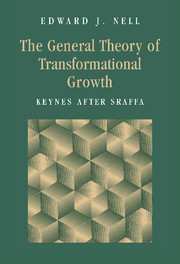Book contents
- Frontmatter
- Contents
- Preface
- Acknowledgments
- Part I History or equilibrium?
- Part II Method and approach: the active mind
- Part III Money and the Golden Rule
- PART IV The wage-profit trade-off
- Part V Investment and Mass Production
- Part VI Money and fluctuations in the modern economy
- 12 Money and interest in the Keynesian system
- 13 Growth and cycles: financially constrained instability under Mass Production
- Conclusions
- Bibliography
- Index
13 - Growth and cycles: financially constrained instability under Mass Production
Published online by Cambridge University Press: 21 January 2010
- Frontmatter
- Contents
- Preface
- Acknowledgments
- Part I History or equilibrium?
- Part II Method and approach: the active mind
- Part III Money and the Golden Rule
- PART IV The wage-profit trade-off
- Part V Investment and Mass Production
- Part VI Money and fluctuations in the modern economy
- 12 Money and interest in the Keynesian system
- 13 Growth and cycles: financially constrained instability under Mass Production
- Conclusions
- Bibliography
- Index
Summary
One basic Keynesian insight is that the economy is demand driven. Another is that it runs on money. Both are correct. But the first had to be recast in the light of transformational growth, and the second reformulated in accordance with the theory of monetary circulation. Now we can draw on both to develop an account of the cyclical pattern of growth of Mass Production.
Actual growth cycles around the trend. Booms and busts follow a more or less regular pattern, generated by the interaction of financial markets with the multiplier. The Mass Production economy is unstable, although not wildly so. But unlike the Craft economy, it is not a stable system destabilized by the monetary/financial system; on the contrary, the labor and commodity markets are highly volatile, and are partly constrained by the financial system. Moreover, the pattern of movement in the Mass Production economy is quite unlike the sawtooth pattern of the Old Growth Cycle; it is more like a succession of hills and valleys, and the reasons for this need to be explained.
Financial markets both constrain, and on occasion, exacerbate the instability that underlies the cycle. The cycle sets up systematic pressures on firms, which inhibit their ability to compete. In particular, firms find themselves carrying excess capacity, and excess inventory. They experience a rise of fixed costs associated with the development of bureaucracy. Their fixed equipment tends to be inflexible.
- Type
- Chapter
- Information
- The General Theory of Transformational GrowthKeynes after Sraffa, pp. 654 - 714Publisher: Cambridge University PressPrint publication year: 1998



